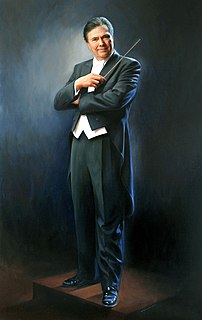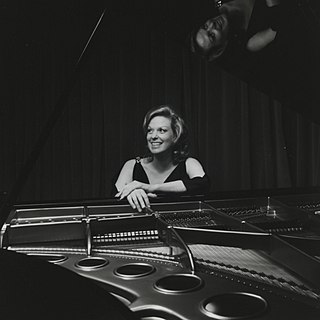Related Research Articles

The Seattle Symphony is an American orchestra based in Seattle, Washington. Since 1998, the orchestra is resident at Benaroya Hall. The orchestra also serves as the accompanying orchestra for the Seattle Opera. Their rendition of Beethoven's "Symphony No. 9, opus 125: Molto vivace" had appeared as a music sample on Windows XP.

Walter Hamor Piston, Jr., was an American composer of classical music, music theorist, and professor of music at Harvard University.

Felix Mendelssohn's Violin Concerto in E minor, Op. 64, is his last large orchestral work. It holds an important place in the violin repertoire and is one of the most popular and most frequently performed violin concertos in history. A typical performance lasts just under half an hour.

Gerard Schwarz, also known as Gerry Schwarz or Jerry Schwarz, is an American symphony conductor and trumpeter. As of 2019, Schwarz serves as the Artistic and Music Director of Palm Beach Symphony and the Director of Orchestral Activities and Music Director of the Frost Symphony Orchestra at the Frost School of Music at the University of Miami.
Symphony No. 3 was Aaron Copland's final symphony. It was written between 1944 and 1946, and its first performance took place on October 18, 1946 with the Boston Symphony Orchestra performing under Serge Koussevitzky. If the early Dance Symphony is included in the count, it is actually Copland's fourth symphony.
David Shifrin is an American classical clarinetist and artistic director.
The New York Chamber Symphony (NYCS) was an American chamber orchestra based in New York City. It was active from 1977 to 2002.

Carol Rosenberger is a classical pianist. In 1976, Rosenberger was chosen to represent America's women concert artists by the President's National Commission on the Observance of International Women's Year. She has given performance workshops for young musicians on campuses nationwide. Rosenberger recorded over 30 albums on the Delos Productions, Inc. recording label. Rosenberger's memoir, To Play Again: A Memoir of Musical Survival was published in 2018 by She Writes Press.
The Symphony No. 8 of Roger Sessions was composed in 1968.
The Symphony No. 2 in D-flat major, Opus 30, W45, "Romantic", was written by Howard Hanson on commission from Serge Koussevitzky for the 50th anniversary of the Boston Symphony Orchestra in 1930, and published by Carl Fischer Music.
Harold Shapero completed the Symphony for Classical Orchestra in B-flat major on March 10, 1947, in Newton Centre, Massachusetts. It is written for an orchestra consisting of piccolo, 2 flutes, 2 oboes, 2 clarinets in B-flat, 2 bassoons, contrabassoon, 2 horns in F, 2 trumpets in C, 2 tenor trombones and one bass, timpani and strings. Although labelled "Classical," many of the work's features point to Beethoven rather than Haydn or Mozart, such as "the way in which Shapero paces himself, alternating long passages in the tonic and the dominant, with fast, dramatic modulations often reserved for transitions and developments." Nicolas Slonimsky remarked on how the piece is "premeditatedly cast in the proclamatory key of B-flat major, the natural tonality of the bugle, and ending in a display of tonic major triads." But there are modern features as well, with "the work's orchestration, in general, ... distinctively bright and brassy, and undoubtedly derived a fair amount from Piston and Copland, as well as from the composer's experience as a dance band arranger."
The Symphony No. 4 by Walter Piston is a symphony dating from 1950.
The Symphony No. 6 by Walter Piston was completed in 1955.
The Symphony No. 5 by Walter Piston was composed in 1954.
The Symphony No. 7 by Walter Piston is a symphony dating from 1960.
The Symphony No. 3 by Walter Piston was composed in 1946–47.
Three New England Sketches by Walter Piston is a symphonic suite dating from 1959.
Walter Piston's Serenata for Orchestra is an orchestral suite or miniature symphony written in 1956.
Walter Piston's Fantasia for Violin and Orchestra was commissioned in 1970 by Mario di Bonaventura, music director of the Hopkins Center Congregation of the Arts at Dartmouth College, who conducted the world premiere on March 11, 1973, performed by the Dartmouth Symphony Orchestra with Salvatore Accardo as the soloist. The commission had been made specifically for Accardo.
Symphony No. 50, Op. 360, Mount St. Helens is a three-movement orchestral composition by the American composer Alan Hovhaness. The symphony was commissioned by former Hovhaness publisher C.F. Peters and was completed January 24, 1982. It premiered March 2, 1984, and was performed by the San Jose Symphony under conductor George Cleve. The piece commemorates the volcano Mount St. Helens, culminating in the events of its 1980 eruption, which Hovhaness had witnessed from his Seattle home.
References
- ↑ Steven Lowe, Liner notes to Walter Piston: Symphonies Nos. 2 and 6. Seattle Symphony, Gerard Schwarz, conducting. Naxos CD 8.559161.
- ↑ Hans Kindler, letter to Walter Piston, March 6, 1944, Washington, D. C: Library of Congress Music Division. Quoted in Pollack 1982 , p. 82
- ↑ Anon., jacket notes for Symphony No. 2 by Walter Piston, American Recording Society Orchestra, conducted by Dean Dixon. Ten-inch 33⅓ R.P.M. Long Playing Record. American Recording Society ARS-1. New York: American Recording Society, 1953.
- ↑ Steven C. Smith, liner notes to Walter Piston, Symphony No. 2, Symphony No. 6, Sinfonietta, Seattle Symphony and the New York Chamber Symphony, conducted by Gerard Schwarz. CD recording. Delos Digital Master Series DE 3074. Hollywood: Delos International, 1990.
- ↑ Steinberg 1995, p. 421.
- ↑ Pollack 1982, p. 83.
- ↑ Elliott Carter, "Walter Piston", The Musical Quarterly 32, no. 3 (July 1946): 354–375 (here 361 and 370–371).
- ↑ Steinberg 1995, pp. 421–422.
Sources
- Pollack, Howard (1982). Walter Piston. Studies in Musicology. Ann Arbor: UMI Research Press.
- Steinberg, Michael (1995). The Symphony: A Listener's Guide. New York and Oxford: Oxford University Press. ISBN 0-19-506177-2, 0-19-512665-3.